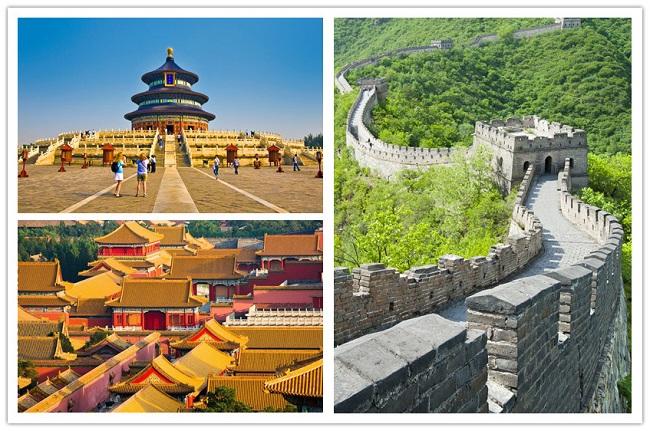China, the world’s most populous country, is a vast land of history, mystery, and stunning natural beauty. Home to one of the oldest civilizations on Earth, it offers travelers a journey through time and an encounter with diverse cultures and traditions.
From the majestic Great Wall to the urban sprawl of Shanghai, the country’s top attractions offer a profound glimpse into China’s soul.
This article will explore the top 10 most visited places in China, where ancient and modern life converge to create unforgettable experiences.

Top 10 Most Visited Places in China
1: The Great Wall of China:
Stretching over 21,000 kilometers, the Great Wall is a marvel of ancient engineering and one of the New Seven Wonders of the World.
The sections near Beijing, like Badaling and Mutianyu, are the most popular among visitors.
2: The Forbidden City, Beijing:
The largest ancient palatial structure in the world, the Forbidden City was the imperial palace for 24 emperors during the Ming and Qing dynasties.
It now houses the Palace Museum, showcasing centuries of Chinese history.
3: Terracotta Army, Xi’an:
Discovered in 1974, the Terracotta Army is a collection of terracotta sculptures depicting the armies of Qin Shi Huang, the first Emperor of China.
It’s considered one of the most significant archaeological finds in the 20th century.
4: The Bund, Shanghai:
A symbol of Shanghai’s historical grandeur, The Bund is a waterfront area famous for its colonial-era buildings and the contrasting modern skyscrapers across the Huangpu River.
5: Li River, Guilin:
Known for its dramatic karst mountain landscape, the Li River is a popular destination for river cruises, especially between Guilin and Yangshuo, offering some of the most picturesque scenery in China.
6: Victoria Peak, Hong Kong:
Offering panoramic views of Hong Kong Island and its skyscrapers, Victoria Harbour, and the green hills of the New Territories, Victoria Peak is a must-visit for stunning cityscapes.
7: Potala Palace, Tibet:
Once the winter residence of the Dalai Lama, this architectural wonder in Lhasa is a spiritual center of Tibetan Buddhism and a UNESCO World Heritage Site.
8: Giant Pandas, Chengdu:
The Chengdu Research Base of Giant Panda Breeding is a conservation center where visitors can see giant pandas and learn about the efforts to protect these national treasures.
9: The Yellow Mountains, Huangshan:
Famous for its granite peaks, pine trees, and hot springs, Huangshan’s mystical landscapes have inspired poets and painters for centuries.
10: West Lake, Hangzhou:
West Lake is renowned for its cultural heritage and natural beauty. It has influenced garden design in China and Japan and has been celebrated by poets and artists since the 9th century.
Conclusion:
China’s top 10 most visited places are just the tip of the iceberg in a country teeming with monumental landmarks and natural wonders.
Each destination tells part of the story of China’s vast historical landscape, rich cultural tapestry, and rapidly evolving modern identity.
Whether it’s your first visit or one of many, these locations promise a journey filled with awe and inspiration.
So pack your bags and get ready to explore the magnificent sights of China, where history comes alive, and every view tells a story.
FAQ: Top 10 Most Visited Places in China
Q1: Do I need a visa to visit China?
A1: Yes, most travelers will need to apply for a visa before visiting China. There are different types of visas, depending on the purpose of your visit. It’s recommended to check the latest visa requirements and application process on the official website of the Chinese embassy or consulate in your country.
Q2: What is the best time of year to visit the Great Wall of China?
A2: The best times to visit the Great Wall are spring (April-May) and autumn (September-October) when the weather is comfortable, and the scenery is beautiful. Summers can be hot and crowded, while winters are cold but offer the chance to see the wall covered in snow.
Q3: How can I avoid crowds at the Forbidden City in Beijing?
A3: To avoid the crowds, try to visit early in the morning right when it opens or later in the afternoon before it closes. Avoiding weekends and Chinese public holidays can also help you escape the largest crowds.
Q4: What should I wear when visiting temples and religious sites in China?
A4: When visiting temples and other religious sites, it’s respectful to dress modestly. Avoid sleeveless tops, shorts, and skirts above the knee. Wearing shoes that are easy to remove is also a good idea since you may need to take them off before entering certain areas.
Q5: Is it easy to find English speakers in China?
A5: In major cities and tourist attractions, you’ll likely find people who speak English, especially in hotels, restaurants, and other places frequented by international visitors. However, it’s less common in rural areas and smaller towns. Learning a few basic phrases in Mandarin can be very helpful.
Q6: Can I use my credit card in China?
A6: Major international credit cards are accepted in many hotels, restaurants, and shops in large cities. However, cash is still widely used, especially in smaller towns and rural areas. It’s advisable to carry some cash for small purchases and in places that may not accept cards.
Q7: What are the must-try foods in China?
A7: China’s culinary diversity is vast, so try to sample local specialties wherever you go. Don’t miss Peking duck in Beijing, dim sum in Hong Kong, Sichuan spicy hot pot in Chengdu, and dumplings in Shanghai.
Q8: Are there any health and safety concerns I should be aware of?
A8: Travelers to China should ensure they are up-to-date on routine vaccinations. Depending on where you’re going, you may also need additional vaccinations or precautions. Always check for travel advisories and health recommendations from reliable sources before your trip.
Q9: What is the best way to travel between cities in China?
A9: China has an extensive high-speed rail network, making it a convenient and efficient way to travel between major cities. Domestic flights are also an option for longer distances, and bus services are available for more regional travel.
Q10: How can I be respectful of Chinese customs and traditions while visiting?
A10: Show respect by greeting people with a nod or a slight bow rather than a handshake, removing your shoes before entering someone’s home, and using both hands when giving or receiving something. Also, be mindful of local etiquette regarding dining, photography, and visiting religious sites.


















































